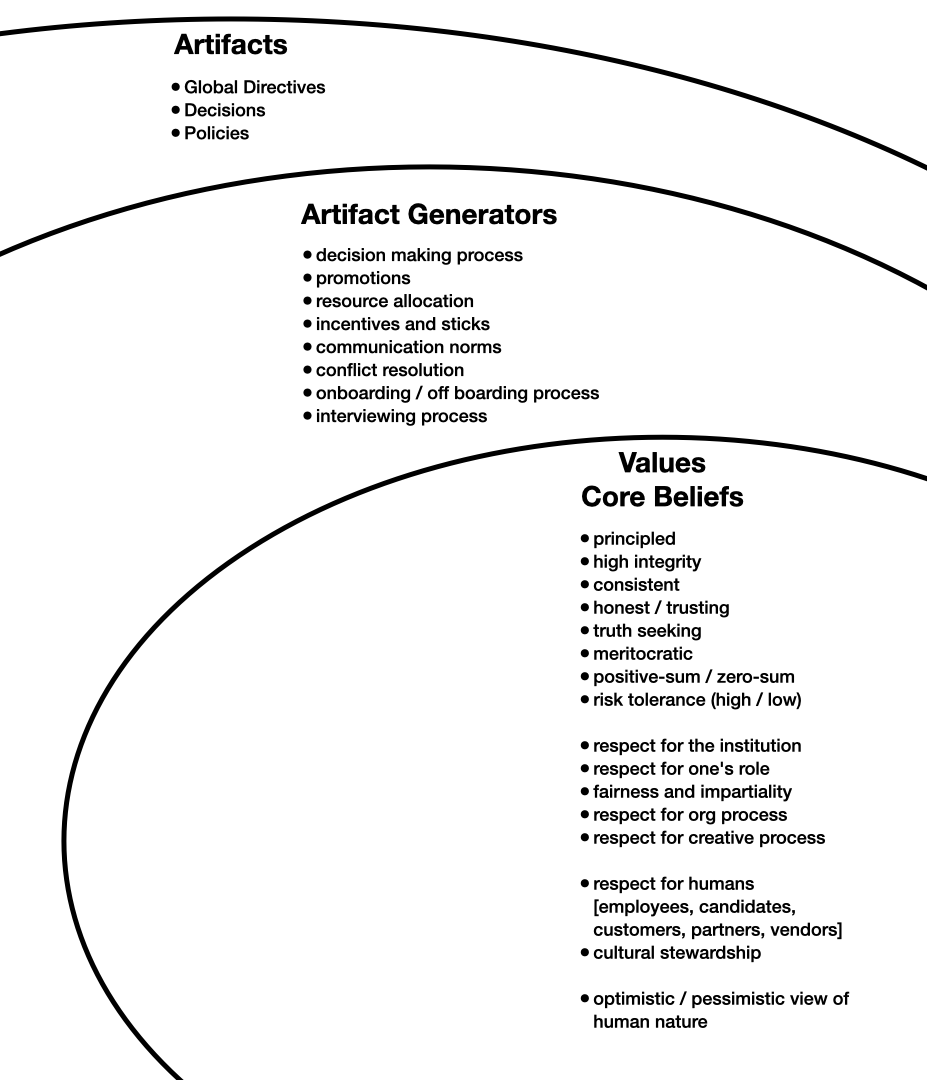The most unnecessary stress and toil in my career has come from letting those tiny cracks of misaligned values grow into a loud dissonance that drains creative energy.
I’ve learned that if you don’t reconcile your values with those of your management chain quickly enough, you’ll find it increasingly difficult to maintain morale and drive top performance. And if high performance is your thing, you’ll exhaust yourself trying to keep up with the new heads of misaligned values popping up in every nook and cranny of the org.
In this post, I’ll cover
- The impact of misaligned values and how they spread through the org
- Blindspots that make it easy to stick your head the sand
- What to do when the dissonance finally becomes loud enough to demand action
- And for the sufficiently foolish, I’ll share tips for confronting entrenched values (in a future post).
Impact of Misaligned Values
When values don’t match, they create heartburn. What does heartburn look like?
Heartburn At ACME Corp
Say leadership at ACME Corp has shown a lack of trust in the team through some new policy or off-the-cuff remark in a Q&A session.
“The new policy requires all employees to submit a daily selfie with their home office clock, to prove they're starting work on time while remote.”
While most people are irked by this, they begrudgingly follow along to avoid losing WFH benefits altogether.
The distrust of the team goes unaddressed and months later, it has metastasized into a full-blown culture of micromanagement at every tier - robbing people of autonomy, killing the creative spirit, and making the numbers go down 📉.
Due to a global mirror shortage and lack of shiny surfaces, the leaders at ACME corp attribute the loss of throughput to their perceived dishonesty of the team. Confirming their initial doubts feels great and cements the distrust. Something needs to be done immediately, so they double down on the failed policy and roll out hourly selfies and restroom logs!

And so on and so forth, “The floggings will continue until morale improves”, and the most fearful enthusiastically cheer on the new policies hoping to be spared for being model citizens.
💡 In this example, had someone challenged the initial distrust of the team, they would have either:
1. learned about a good blindspot, or
2. corrected a miscommunication and restored trust, or
3. learned that the distrust is deeply rooted and needs a different approach altogether
Instead, they find themselves busy tackling ever more intrusive reincarnations of the selfie policy in a distrust loop that seems to go faster and cut deeper with each cycle.
How Misaligned Values Percolate Through the Org
Before we get to the root of the heartburn, it's important to understand how it moves through an org.
- Employees experience it through artifacts:
- policies, decisions and global directives.
- Managers experience it when wrestling with the processes generating those artifacts:
- decision making process, performance management, incentive distribution, resource allocation, risk tolerance, …
- Founders and execs hold core values that shape the operating system of the company but they don't directly experience the heartburn
- Instead, they see it reflected in the numbers and the quality of the product.
- ⚠️ And sometimes, when things don’t look so good, they do as most humans do and orient outward looking for answers vs. searching within.
- ⚠️ Some people can don different masks and hold incompatible sets of values. If your moral code doesn’t distinguish between masks, compartmentalizing your actions at work and processing them using different moral frameworks will not be available to you. You have no choice but to reconcile.

Convenient Distractions
Below I’ve cataloged a number of factors that make it easy to bury one’s head in the sand. (Not all items are from direct personal experience, but are included for completeness).
- Growing revenue [and slaying dragons with a badass team] can hide a lot of problems and be very intoxicating
- There is nothing like starting in the trenches with a team of highly capable, creative humans, and growing together to advance the business, solve tough technical problems, and give back via blog posts, university collaborations, and design partnerships.
- ⚠️ Fixating on internal execution can make it easy to ignore misalignment and seek comfort in crushing OKRs.
- Overextending The Benefit of the Doubt
- Chances are you’re coming into a new org with a positive outlook hoping to create something special.
- Maybe you secretly don’t want the bubble to burst too early, or you genuinely believe in the goodness of people - either way, as you interact with new colleagues, it’s natural to channel that positivity and write off early indicators of conflicting values.
- 💡 Remember, a single clarifying example can be enough to assess character. Endlessly looking for new data or offering too many second chances is a good indicator of denial.
- Being Oversubscribed
- ⚠️ Beware of environments filled with continuous stress and fabricated urgency as they might keep you too preoccupied to notice or too drained to act on organizational smells.
- 💡 Develop good personal boundaries.
- Lack of Psychological Safety
- ⚠️ Some leaders may inadvertently shift goal posts and create inconsistent definitions of success, making it really hard to know where you stand. Whether due to incompetence, or not, keeping people on shaky grounds (especially during down markets) removes the psychological safety needed to provide honest feedback.
- 💡 A good practice is to memorialize goals, strategies, and decisions on paper, and capture sign-offs and comments in written form. (Also great for org-wide review and reflection, onboarding, …)
- Unwelcome Feedback
- At times leaders can signal that challenging global policy is futile.
- This can be subtle, like by providing superficial answers or paying lip service and never taking action. Or it can be more overt, like diverting the discussion from values to a recent setback, forcing you to drop it and take a defensive posture.
- 💡 The silver lining is that this sort of behavior itself is a great signal of operating principles.
- Reconciliation is hard!
- With peers, you only need to find a common set of mutually held values to effectively work together. Along your management chain, you have to reconcile and merge value systems. This is a much harder and often fruitless task, so it’s easy to put off.
- Aligning Values
- Finding an overlapping set of values that can be agreed on to unblock decisions and actions.
- Works great laterally.
- Reconciling Values
- Finding a way to coexist through updating value systems to bring them closer together.
- Requires compromise and being able to let go of long held beliefs (good luck on both sides).
- Often needed when faced with misaligned values along management chain.
Dealing with Misaligned Values
Eventually, the heartburn reaches your team. People are asking you to clarify some new global policy here, or explain some seemingly unprincipled decision there.
Option 1: Fully Commit and Toe the Company Line
- Overwrite your values and sell the kool aid to your team.
- If you can’t risk getting axed, or if the honey is too sweet, you may take this path, but be warned:
- ⚠️ Letting go of your values and acting against your grain is like losing a piece of yourself.
- ⚠️ Failing to uphold your values will be a betrayal of those who followed you and if word spreads, you’ll have trouble attracting good folks to work with in the future.
- ⚠️ You might try to quell the dissonance with clever stories and motivated reasoning. But even if you succeed at deceiving yourself, chances are your team will see through it and lose trust in you. And eventually, your fragile facade of self deception may crumble and cause a deep internal crisis 💥.
- ⚠️ This area is fertile for soul-trading and will leave you unfulfilled and burned out.
Option 2: Ignore Misaligned Values, Fight Misaligned Policies (Unsustainable)
- Do the bare minimum required to comply with the global policy
- Behind the scenes, do all that you can to repeal it, tone it down, or at least get your team exempted from it.
- Maintain your values, and be honest with your team (no kool aid)
- “Hey folks, I agree that this is a dumb policy but let’s adhere for now till I figure out wtf is going on!”
- While it’s sometimes the only reasonable option, I’m not a fan of this as it’s a sign of discordant leadership incapable of marching in unison. It’s ok for leadership to disagree on all sorts of things, but deep values, which define the rules of the game, require total alignment.
- 💡 When in doubt, it’s better to maintain trust and lose face in some other way
- 💡 This is not a stable solution as it doesn’t actually reconcile anything. Yet, this is where I found myself while trying to juggle conflicting value systems. I assumed that by challenging policies one by one, I could shine the light on the misaligned core values and impact change - in retrospect, it would have been more efficient to go directly after the values.
- ⚠️ If you take this path, you accept a small chance of getting sacked due to insubordination or simply being perceived as a thorn. In many companies, at the leadership level you’re sort of expected to fully comply with GTFO no matter how righteous you might feel or how correct you might actually be.
Option 3: Attempt to reconcile values (future post)
After kicking yourself for letting issues simmer for so long, you assess the situation and decide to act both for your own sanity and your team’s health. Better to go after the root of the problem and reconcile values once and for all vs. die through a thousand cuts…. (more to come in a future post).
Option 4: Resign
Accept that values have drifted too far and find new company. This will be hard to do as you may feel the need to stay and fix things from the inside and protect your team, especially those who directly followed you.
Overall, when you notice a divergence between your values and those of your org, you need to address it immediately. Otherwise, managing the impact of the growing gaps becomes increasingly challenging. Ideally, you should either reconcile these differing values swiftly or consider a new team where values are better aligned.
